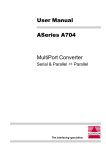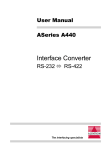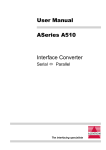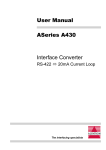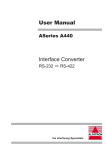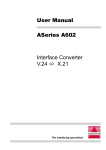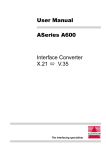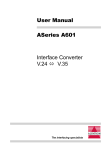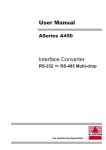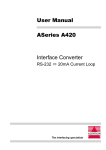Download ASeries A451 User Manual Interface Converter
Transcript
User Manual ASeries A451 Interface Converter RS-232 RS-485 Multidrop The interfacing specialists A451 User Manual Version 1.00 April 2000 COPYRIGHTS All rights reserved. This document may not, in whole or part, be copied, photocopied, reproduced, translated, or reduced to any electronic medium or machine readable form without the express permission in writing from Alfatron Pty Ltd. Copyright 2000 © Alfatron Pty Ltd DISCLAIMER Alfatron Pty Ltd has made every attempt to ensure that the information contained in this document is accurate and complete. Alfatron Pty Ltd makes no representation or warranties of merchantability or fitness for any particular purpose. Alfatron Pty Ltd reserves the right to make changes to this document at any time, without notice. Therefore, Alfatron Pty Ltd assumes no liability for damages incurred directly or indirectly from errors, omissions or discrepancies with the hardware and the manual. TRADEMARKS All Company and Product names are trademarks of the Company or Manufacturer respectively. WARRANTY Alfatron warrants its products against defects in materials and workmanship for a period of one year from receipt by the customer. All warranty is carried out on a return to depot basis unless an alternative warranty coverage has been arranged. WARRANTY EXCLUSIONS The above warranty shall not apply to defects resulting from improper or inadequate maintenance by the customer, unauthorised modifications or misues, operation outside the environmental specifications for the product, damage due to power surges, lightening strikes or any other phenomenon outside normal operational specifications. Alfatron Pty Ltd ACN: 005 410 819 P.O. Box 4161 Unit 9/36 New St. Ringwood VIC 3134 AUSTRALIA Email: [email protected] Web Site: www.alfatron.com.au A451 User Manual 1.0 PRODUCT DESCRIPTION The ASeries A451 is an RS-232 to RS-485 Multidrop interface converter using standard RJ-45 Ethernet cabling on the RS-485 side. On the RS-232 side a DCE/DTE switch is provided for easy reversing of the TD and RD signals. The RS-485 port will support up to 32 drivers and 32 receivers over a cable length of 1200 metres at speeds up to 115Kbps.Transient Protection is also provided on the RS-485 lines. Full Duplex (4 wire) or Half Duplex (2 wire) operation may be used on RS-485 and internal jumper settings permit the use of either 'standard' or 'crossed' Ethernet cables. The layout of the A451 is as follows: DCE / DTE Selection Power Jack RS-232 RD (Green) RS-232 Port RS-485 Connectors ON SW1 RS-485 RD (Green) DIP Switch Figure 1 - A451 viewed from all sides 2.0 INSTALLATION Before installing the A451 please make sure that the DIP Switch settings are according to the requirement of the RS-485 target device. It is also important to select the RS-232 port as either DCE or DTE. Make sure that all cables are terminated and then insert the power plug into the jack socket and turn the power ON. The A451 is now ready for use. 2.1 LED indicators The LEDs will operate only if DIP Switch 7 is set to the 'ON' position. The RD (RS-232) LED indicator will flash each time data is being received by the Serial RS-232 Port. The RD (RS-485) LED indicator will flash each time data is being received by the RS-485 Serial Port. These LEDs will not operate at any other time. 1 A451 User Manual 3.0 INTERFACE APPLICATION NOTES 3.1 About the RS-232 Port The RS-232 connection is switch selectable as either DTE or DCE. For connection to a standard PC with a straight through serial cable, select DCE. When operating the A451 without the power adapter it is necessary to connect the CTS/RTS and DTR/DSR signals as the power is drawn from these lines. In most applications, it is necessary to connect all of the commonly used pins on the RS-232 port ( i.e. 1, 2, 3, 4, 5, 6, 7, 8 and 20 on a DB25 interface ). 3.2 About the RS-485 Port The RS-485 port may be configured for either a 4-wire or a 2-wire network. This is done simply be choosing the appropriate jumper setting on the connector JP1 located behind the RJ-45 sockets, as follows: 2 Pin 1 2 3 4 5 6 7 8 Description of Signal Transmit Data Plus (TD+) Transmit Data Minus (TD-) Receive Data Plus (RD+) Receive Data Minus (RD-) Ground Ground 1 Pin 1 2 3 4 5 6 7 8 Description of Signal Receive Data Plus (RD+) Receive Data Minus (RD-) Transmit Data Plus (TD+) Transmit Data Minus (TD-) Ground Ground 1 Pin 1 2 3 4 5 6 7 8 Description of Signal (RD+) and (TD+) (RD-) and (TD-) Ground Ground 1 JP1 Standard 4-wire (Factory Default) JP1 Crossed 4-wire Configuration JP1 2-wire Configuration A451 User Manual 3.3 Other RS-485 Considerations When installing an RS-485 2-wire network the RS-485 transmitter must be controlled by the RS-232 serial device. This transmitter may be controlled by either the RTS/CTS or DTR/DSR signals. If the RS-232 side is using software to control devices then it may require a local echo of what it transmits, if so, turn DIP Switch 6 to the 'OFF' position. If the distance of the RS-485 device is less than 100metres then it is not necessary to terminate the RS-485 bus. 3.4 Using A451s as RS-232 Line Extenders A pair of A451s may be used to extend the distance at which RS-232 data is transmitted. The A451s are connected via their RS-485 ports to take advantage of the greater data transfer distances achievable with RS-485. The following examples show how to connect two A451s together via their RS-485 ports using various cable types. Note that the internal jumper JP1 must be set as per these diagrams. Example 1: 1 Using a Standard RJ-45 Ethernet Cable JP1 1 JP1 1 JP1 Straight Through Cable A451 Socket Example 2: 1 A451 Socket Using a Crossed RJ-45 Ethernet Cable JP1 Crossed Cable A451 Socket A451 Socket Note: Using a Crossed Cable requires no changes to the Factory Set JP1 3 A451 User Manual 4.0 CONFIGURATION OF THE RS-485 PORT 4.1 RS-485 DIP Switch Settings DIP Switch Function 1 2 3 4 5 on off off off off RS485 transmitter Enabled when DTR/DSR is High off on off off off RS485 transmitter Enabled when RTS/CTS is High off off off off off RS485 transmitter ALWAYS Enabled off off on off off RS485 transmitter NEVER Enabled off off on on on Monitor Mode DIP Switch Setting Function OFF RS485 receiver always enabled (local echo for 2-wire RS485) ON RS485 receiver enabled only when RS485 transmitter disabled OFF LEDs always OFF. Saves power in 'non powered' operation ON LEDs indicate RD/TD Data Flow OFF No termination on RS485 receiver ON 120ohm termination on RS485 receiver 6 7 8 4.2 Factory Default RS-485 DIP Switch Settings 4 RS-485 Transmitter ALWAYS enabled RS-485 Receiver ALWAYS enabled (local echo for 2-wire RS-485) LEDs indicate RD/TD Data Flow No Termination on RS-485 Receiver A451 User Manual 5.0 INTERFACE PORT PIN ASSIGNMENTS 5.1 RS-232 Serial Port Pinout 5.2 Pin Status Set for DCE Set for DTE 1 2 3 4 5 6 7 8 20 Used Input / Output Output / Input Linked to Pin 5 Linked to Pin 4 Linked to Pin 20 Used Not used-Pulled High 4K7 Linked to Pin 6 Frame Ground RD TD CTS RTS DTR Signal Ground DCD DSR Frame Ground TD RD RTS CTS DSR Signal Ground DCD DTR Note: Pins 4, 5, 6, 8 and 20 are pulled to the correct levels to allow a PC serial port to operate under most conditions without any additional loopback connections. Factory Default DCE/DTE Switch Setting The Factory Default for the RS-232 Port is DCE. 5.3 RS-485 Serial Port Pinout Pin number 1 for each RJ-45 connector is shown here in the diagram. The two RJ-45 connectors are identical in pin assignment and are connected in parallel. Pin 1 Pin 1 The signals associated with each pin depend on the configuration of the jumper JP1. Please refer to Section 3.2 for these details. 5.4 Factory Default JP1 Jumper Setting The A451 is shipped with JP1 set to Standard 4-wire configuration as shown here: 1 JP1 Standard 4-wire (Factory Default) 5 A451 User Manual 6.0 CABLE GROUNDING Alfatron recommends the use of shielded cable with all of its products. Shielding reduces EMI Radiation and improves noise immunity. This helps minimise interference to other equipment and will improve communications reliability. 6.1 RS-232 Cable Construction The recommended cable construction is as follows: 6.2 Take the shield (surrounding cable wires) and solder it to the Frame Ground (FG) pin. If FG is not available, use Signal Ground (SG) but in this case always use a separate wire for ground which is connected at both ends. The shield must be connected at both ends of the cable. RS-485 Cable Construction While the RS-485 differential signal does not require a ground signal for communication, we recommend that a ground wire is always connected in an RS-485 Multidrop Network. The longer distances available with RS-485 can present significant differences in the voltage levels of the 'Ground' signal. This can lead to loss of data and at the extreme, cause damage to the equipment. 7.0 CABLE EXAMPLES 7.1 RS-485 Cable from A451 to User Device Pin A451 Socket RJ-45 Standard 4-wire (Factory Default) 6 Pin 1 Pin 2 TD+ TD- Pin 3 RD+ RDTD+ Pin 6 RD- TD- Pin 7 GND GND RD+ User Device A451 User Manual 7.2 RS-232 Connection to a PC with a DB-25 Serial Connector Shield A451 Cable End DCE (DB-25 Male) 7.3 FG RD TD CTS RTS DTR SG DCD DSR 1 2 3 4 5 6 7 8 20 1 2 3 4 5 6 7 8 20 FG TD RD RTS CTS DSR SG DCD DTR PC Cable End DTE (DB-25 Female) RS-232 Connection to a PC with a DB-9 Serial Connector Shield A451 Cable End DCE (DB-25 Male) 7.4 RD TD CTS RTS DTR SG DCD DSR 3 2 7 8 6 5 1 4 2 3 4 5 6 7 8 20 TD RD RTS CTS DSR SG DCD DTR PC Cable End (DB-9 Female) RS-232 Cable for Other Devices Shield A451 Cable End DCE (DB-25 Male) FG RD TD CTS RTS DTR SG DCD DSR 1 2 3 4 5 6 7 8 20 FG TD RD RTS CTS DSR SG DCD DTR User Device Cable End 7 A451 User Manual 8.0 SPECIFICATIONS RS-232C Port: RS-485 Port: LED Indicators: Power Supply: Asynchronous RS-232C/V.24 Select as DCE or DTE DB-25 female connector Speed capability dependant on cable length up to 64k bits per second RS-485 Two RJ-45 connectors for multidrop setup Switchable 120ohm Termination for RD line Receive Data - RS-232 (Green) Receive Data - RS-485 (Green) 9V (200mA) DC Power Adapter Reverse polarity protection Plug jack - 5.5mm outer/2.5mm inner diameter Polarity is Outer Negative Dimensions: Weight: Operating Temperature: Stroage Temperature: 84mm x 58mm x 23mm 160 grams 10° to 35° C 0° to 45° C All specifications subject to change without notice 8 N42 DECLARATION OF CONFORMITY according to the European Commissions EMC Directive 89/336/EEC We, of, Name of Manufacturer: Address of Manufacturer: Australian Company Number: ALFATRON PTY. LTD UNIT 9, 36 NEW ST. RINGWOOD VIC 3134 AUSTRALIA ACN: 005 410 819 declare under sole responsibility that the product: Product Name: ASeries RS-232 < > RS-485 Interface Converter Model Number: A451 to which this declaration relates is in conformity with the following standards: CISPR-22 / EN 55022 class B IEC 801-2 / prEN55024-2 IEC 801-3 / prEN55024-3 IEC 801-4 / prEN55024-4 EMI from Information Technology Equipment (ITE) Electro Static Discharge Immunity Radiated RF Immunity Electrical Fast Transients Immunity











